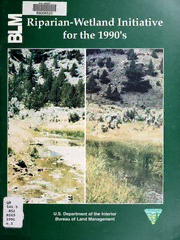
Riparian-Wetland Initiative for the 1990s PDF
Preview Riparian-Wetland Initiative for the 1990s
Riparian-Wetland Initiative for the 1990's U.S. Department of the Interior Bureau of Land Management Riparian-Wetland Initiative for the 1990’s BLMAVO/GI-91/001+4340 U.S. Department of the Interior Bureau of Land Management September 1991 United States Department of the Interior BUREAU OF LAND MANAGEMENT WASHINGTON, D C. 20240 OFFICEOFTHEDIRECTOR Dear Secretary Lujan: Riparian-wetland areas comprise less than 10 percent ofthe 270 million acres ofpublic lands administered by the Bureau ofLand Management. The benefits of these vital oases, however, far exceed the relatively small acreage they occupy. One ofmy chief goals is to achieve proper functioning conditions on these 23.7 million acres, in order to provide the widest variety ofvegetation and habitat diversity for wildlife, fish, livestock, and watershed protection. This Riparian-Wetland Initiative summarizes our management efforts to date and sets forth our goals and the strategies to achieve them. It is an ambitious program, but with the support of the public, the Congress, and all affected interests, we will succeed in meeting our overall goal ofhealthy riparian-wetland areas. Everyone can be a winner if wejust work together. September 1991 BLM Director, 11 Contents Director's Letter to the Secretary iii Executive Summary 1 Introduction 3 What is a Riparian-Wetland Area? 3 A Alaska Wetlands - Special Situation 4 Importance of Riparian-Wetland Areas 6 Approach to Management of Riparian-Wetland Areas 9 Background on BLM’s Efforts 9 Planning 9 Internal Program Coordination 9 External Cooperation and Coordination 9 Cooperative Funding Process 10 Status of Riparian-Wetland Areas 1 Management Status 11 Functioning Condition 1 Ecological Status 13 Future Management ofRiparian-Wetland Areas 15 — Goal Number 1 Restoration and Maintenance 16 Management Opportunities 16 Strategies 16 — Goal Number 2 Protection 23 Management Opportunities 23 Strategies 23 — Goal Number 3 Information and Education 26 Management Opportunities 26 Strategies 26 — Goal Number 4 Coordination and Cooperation 28 Management Opportunities 28 Strategies 29 Estimated Costs and Human Resources 31 Wetland Improvement Strategies 31 Riparian Area Management Strategies 31 Human Resources Needs 32 — A Appendix Glossary 33 — Appendix B National Riparian Policy Statement 35 — Appendix C Accomplishments 39 — D Appendix Legislation, Executive Orders, and Policy 41 — Appendix E Summary of5-Year Additional Riparian Funding Requirements by State 43 — Appendix E— Summary of5-Year Additional Riparian Funding Requirements by State 43 Appendix F —Map of Showcase Areas on Public Lands in Western U.S 45 G Appendix List ofSources for Information and Publications 49 VI Summary Executive ThisRiparian-WetlandInitiativeforthe 1990’s mine current ecological status, potential, and providesablueprintformanagementandrestoration condition. ofriparian-wetland areas encompassing 23.7 mil- lion acres of BLM lands. This overall national • Land Use and Activity Plan Preparation/ strategy complements other plans such as Water- Revision. Develop/revise plans that involve A fowl Habitat Management on Public Lands, riparian-wetland areas prescribing actions to Strategy for the Future; Fish and Wildlife 2000; meet management objectives. Range of Our Vision; and Recreation 2000 in an interdisciplinary, multi-program, cooperative ef- • Project Development/Maintenance. Com- fort. plete projects such as fences, water develop- Four nationwide riparian-wetland goals have ments,treeplanting,prescribedfire,andhabitat been established: improvement structures to create, improve, and/or maintain riparian-wetland conditions. Restore and maintain riparian-wetland areas Maintain projects to continue their beneficial <• so that 75 percent ormore are in proper func- use. tioning condition by 1997. The overall ob- jective is to achieve an advanced ecological • Monitoring. Monitor to determine if man- status, except where resource management agementactionsaremeetingspecificobjeaives objectives, including proper functioning con- for riparian-wetland areas. dition, would require an earlier successional stage. • Protection/Mitigation. Avoidormitigatethe impact of surface disturbance activities on • Protect riparian-wetland areas and associated riparian-wetland areas. uplands through properland management and avoid or mitigate negative impacts. Acquire • Acquisition/Expansion. Acquire andexpand and expand key areas to provide for their riparian-wetland areas primarily throughland maximum public benefit, protection, en- exchanges. hancement, and efficient management. Achievingthe goalsis contingentonreceiving • Ensure an aggressive riparian-wetland infor- the necessary funding, support, and cooperation. mation/outreachprogram includingproviding The approximate cost to achieve the riparian , training and research. partofthis Initiative is estimated to be $85 million A from 1991 to 1995. total of 300 additional » Improve partnerships and cooperative resto- riparianpositions ofvariousskillswillberequired. ration and management processes in imple- The wetland management part of this Initiative menting the riparian-wetland initiative. will require approximately $10 million for inven- tory, coordination and partnerships, and planning Broad-based implementation strategies to habitat developmentoverthe next 10 years. Also, achieve these goals have been established as well, it is estimated that it will cost approximately $32 withthe majorstrategies faUing into the following milliontoimplementtheplannedriparian-wetland categories: expansions andacquisitionsoverthenext20years. In summary, the total cost will be approximately • Inventory/Classification. Collect, compile, $127million,plus $2millionannually forwetland and evaluate baseline information to deter- maintenance. 1 This Initiative does not establish specific ob- jectives and priorities to implement this Initiative jectives orpriorities foractions. Most actions wiU consistent with laws, regulations, policy, and betaken atthe fieldlevel. Eachstate, throughtheir funding. individual strategic plans, establishes specific ob- 2
